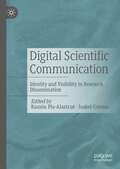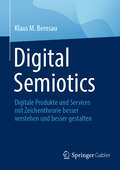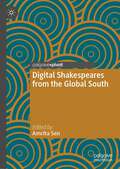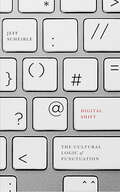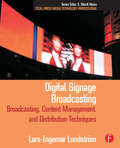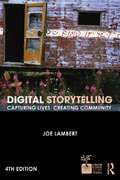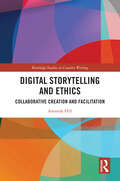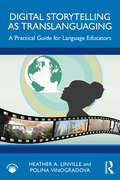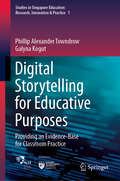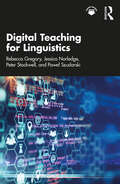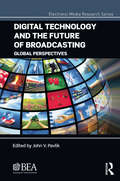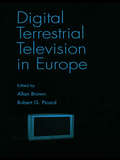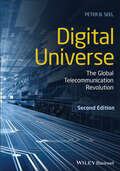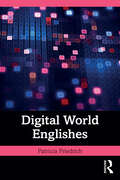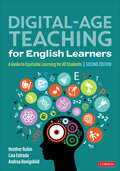- Table View
- List View
Digital Scientific Communication: Identity and Visibility in Research Dissemination
by Ramón Plo-Alastrué Isabel CoronaThis edited book analyses current trends in science communication and gathers research on practices related to the construction of digital identity and visibility, emerging conflicts related to the public availability and appropriation of scientific culture, and ways of validating and disseminating scientific knowledge in new digital contexts. Drawing on a selection of papers presented in the InterGedi Conference (Zaragoza, December 2021), the main goal of the volume is to identify and explore emerging professional practices and challenges in the digital communication of science through innovative multimodal genres. This book will be of interest to postgraduates, doctoral students, practitioners and researchers in the fields of discourse analysis, sociolinguistics, digital media, multimodality and communication studies.
Digital Semiotics: Digitale Produkte und Services mit Zeichentheorie besser verstehen und besser gestalten
by Klaus M. BernsauDieses Buch erklärt, wie Unternehmen mit Hilfe der Semiotik – der Lehre von den Zeichen – ihre digitalen Produkte und Dienstleistungen erfolgreicher machen können. Denn die Wellness-App, der Warenkorb im Onlineshop oder der Like-Button in der Produktansicht haben eines gemeinsam: Sie basieren auf digitalen Zeichen. Diese kundengerecht einzusetzen, wird immer mehr zum Schlüssel für das Produkterlebnis und damit zur Voraussetzung für den Produkterfolg. Die moderne Semiotik verbindet Sprachwissenschaft, Erkenntnistheorie, Anthropologie, Psychologie und Sozialwissenschaften zu einem faszinierenden Blick auf digitale Angebote. Der Autor zeigt, wie Unternehmen diese Erkenntnisse nutzen können und liefert ein praxisnahes Buch für Produktmanager*innen, Marketer*innen, Kommunikator*innen, Designer*innen, Softwareentwickler*innen – kurz: für alle, die für digitale Produkte und Dienstleistungen verantwortlich sind.
Digital Shakespeares from the Global South (Global Shakespeares)
by Amrita SenDigital Shakespeares from the Global South re-directs current conversations on digital appropriations of Shakespeare away from its Anglo-American bias. The individual essays examine digital Shakespeares from South Africa, India, and Latin America, addressing questions of accessibility and the digital divide. This book will be of interest to students and academics working on Shakespeare, adaptation studies, digital humanities, and media studies.Included in this volume, the chapter on “Finding and Accessing Shakespeare Scholarship in the Global South: Digital Research and Bibliography” by Heidi Craig and Laura Estill is available open access under a Creative Commons Attribution 4.0 International License via link.springer.com.
Digital Shift: The Cultural Logic of Punctuation
by Jeff ScheibleEmoticons matter. Equal signs do, too. This book takes them seriously and shows how and why they matter. Digital Shift explores the increasingly ubiquitous presence of punctuation and typographical marks in our lives⎯using them as reading lenses to consider a broad range of textual objects and practices across the digital age. Jeff Scheible argues that pronounced shifts in textual practices have occurred with the growing overlap of crucial spheres of language and visual culture, that is, as screen technologies have proliferated and come to form the interface of our everyday existence. Specifically, he demonstrates that punctuation and typographical marks have provided us with a rare opportunity to harness these shifts and make sense of our new media environments. He does so through key films and media phenomena of the twenty-first century, from the popular and familiar to the avant-garde and the obscure: the mass profile-picture change on Facebook to equal signs (by 2.7 million users on a single day in 2013, signaling support for gay marriage); the widely viewed hashtag skit in Jimmy Fallon&’s Late Night show; Spike Jonze&’s Adaptation; Miranda July&’s Me and You and Everyone We Know; Ryan Trecartin&’s Comma Boat; and more. Extending the dialogue about media and culture in the digital age in original directions, Digital Shift is a uniquely cross-disciplinary work that reveals the impact of punctuation on the politics of visual culture and everyday life in the digital age.
Digital Signage Broadcasting: Content Management and Distribution Techniques
by Lars-Ingemar LundstromDigital Signage Broadcasting is a perfect introduction to this new world of opportunities for media professionals in all areas. Whether you are in engineering, IT, advertising, or management, you will gain knowledge on the operations of digital signage systems, content gathering, customer billing, and much more on this new exciting media.This book includes coverage of basic elements, examples of advanced digital signage applications, as well as traffic capacity calculations that may be guidance when choosing means of distribution as physical media, broadband or satellite. Digital Signage Broadcasting helps you discover the fascinating possibilities of this new convergence medium with hundreds of author-created color 3D illustrated graphics and real-life photographs showing the capability and future of digital signage.
Digital Signage: Software, Networks, Advertising, and Displays: A Primer for Understanding the Business
by Jimmy SchaefflerDigital Signage gives you macro and micro views of the burgeoning digital signage industry. Whether you are looking for new opportunities or to expand your business, with this book you will be able to clearly understand and accurately analyze the developments, trends and projections. As part of the NAB Executive Technology Briefing series, this book features the future impact of the technology across many different industries and platforms. Explanations of hardware such as displays, servers, and PCs, software such as dynamic on-screen content and software management programs, and technologies like systems integrations and network infrastructures are all covered.
Digital Storytelling
by Joe LambertListen deeply. Tell stories. This is the mantra of the Center for Digital Storytelling (CDS) in Berkeley California, which, since 1998 has worked with nearly 1,000 organizations around the world and trained more than 15,000 people in the art of digital storytelling. In this revised and updated edition of the CDS's popular guide to digital storytelling, co-founder Joe Lambert details the history and methods of digital storytelling practices. Using a "7 Steps" approach, Lambert helps storytellers identify the fundamentals of dynamic digital storytelling--from seeing the story, assembling it, and sharing it. As in the last edition, readers of the fourth edition will also find new explorations of the applications of digital storytelling and updated appendices that provide resources for budding digital storytellers, including information about past and present CDS-affiliated projects and place-based storytelling, a narrative-based approach to understanding experience and landscape. A companion website further brings the entire storytelling process to life. Over the years, the CDS's work has transformed the way that community activists, educators, health and human services agencies, business professionals, and artists think about story, media, culture, and the power of personal voice in creating change. For those who yearn to tell multimedia stories, Digital Storytelling is the place to begin.
Digital Storytelling
by Shilo T. MccleanComputer-generated effects are often blamed for bad Hollywood movies. Yet when a critic complains that "technology swamps storytelling" (in a review of Van Helsing, calling it "an example of everything that is wrong with Hollywood computer-generated effects movies"), it says more about the weakness of the story than the strength of the technology. In Digital Storytelling, Shilo McClean shows how digital visual effects can be a tool of storytelling in film, adding narrative power as do sound, color, and "experimental" camera angles--other innovative film technologies that were once criticized for being distractions from the story. It is time, she says, to rethink the function of digital visual effects. Effects artists say--contrary to the critics--that effects always derive from story. Digital effects are a part of production, not post-production; they are becoming part of the story development process. Digital Storytelling is grounded in filmmaking, the scriptwriting process in particular. McClean considers crucial questions about digital visual effects-- whether they undermine classical storytelling structure, if they always call attention to themselves, whether their use is limited to certain genres--and looks at contemporary films (including a chapter-long analysis of Steven Spielberg's use of computer-generated effects) and contemporary film theory to find the answers. McClean argues that to consider digital visual effects as simply contributing the "wow" factor underestimates them. They are, she writes, the legitimate inheritors of film storycraft.
Digital Storytelling and Ethics: Collaborative Creation and Facilitation (Routledge Studies in Creative Writing)
by Amanda HillDigital Storytelling and Ethics: Collaborative Creation and Facilitation provides a method for analyzing digital storytelling practices that focuses on the rhetorical, dialogic, co-productive, creative storymaking space rather than the finished stories or the technologies. Looking through a new media lens, Amanda Hill situates the digital storytelling genre and writing practice as a co-creative media process created between writers, storytellers, educators/facilitators, institutions, and the audience, and discusses the inter-relationships within the collaborative writing workshop as well as in those found in the dissemination of the final digital stories. Digital Storytelling and Ethics provides a reflexive look at the responsibility of the facilitator in co-creative digital storytelling writing spaces and makes use of diverse international case studies as examples. Hill shows that writing educators/facilitators should interpret their roles within the collaborative creation process. This will ensure that responsible facilitation practices based in witnessing guide the storytelling process and create an environment that treats participants as subjects with the ability to respond to the world. This innovative book is an essential read for collaborative digital writers and facilitators.
Digital Storytelling as Translanguaging: A Practical Guide for Language Educators
by Heather A. Linville Polina VinogradovaThis innovative, accessible book is an introduction to using digital storytelling in language teaching, with a focus on English as an Additional Language (EAL) instruction. Linville and Vinogradova provide a clear framework that addresses translanguaging and multimodal meaning making in teaching multilingual learners (MLs) through use of digital storytelling.This book provides detailed guidance on how to incorporate digital storytelling into language teaching, building on recent developments in the fields of TESOL and language education that position multilingualism and multiliteracies as important components of any language instruction. Through this text and accompanying activities, readers will understand how to work with MLs to create multimodal digital texts. This book offers an easy-to-follow, step-by-step process for language educators to follow to support MLs’ digital storytelling projects in any EAL classroom. Featured digital storytelling projects from EAL practitioners in various contexts, as well as multiple examples and resources, are included for each stage of the process, always grounded in contemporary TESOL theories (e.g., critical pedagogy, culturally responsive teaching, translanguaging, and a pedagogy of multiliteracies). This framework supports the development of multilingualism and multiliteracies and can be adapted by educators of other world languages for any language education setting.Grounded in contemporary TESOL theories, this book is an essential text for courses on technology in TESOL and TESOL methods courses, as well as for language educators.
Digital Storytelling for Educative Purposes: Providing an Evidence-Base for Classroom Practice (Studies in Singapore Education: Research, Innovation & Practice #1)
by Phillip Alexander Towndrow Galyna KogutThis book is an exposition of a curriculum innovation within the complex yet fertile ground of school-based education in Singapore. Beyond straightforward descriptions and protocols, this book purposefully connects classroom practices with theories in a clear, uncomplicated way. The result provides a series of rationales for action, reflection and understanding that other publications in digital storytelling sometimes fail to cover or explain in sufficient detail. Broadly, these include digital multimodal authorship; teachers’ and students’ storytelling task design and assessment; the use of digital storytelling as a reflective and reflexive expression of teachers’ professionalism; and dialogism in classroom practice.
Digital Storytelling in the Classroom: New Media Pathways to Literacy, Learning, and Creativity
by Jason B. OhlerA must-read for incorporating digital literacy into your classroom! Equip your students with essential 21st-century media literacy skills, as they read, write, speak, and create art within the context of digital storytelling, and reach deeper understandings in all areas of the curriculum! In this second edition, both novice and technologically adept K-12 educators will find: Practical techniques to combine storytelling with curriculum content Tips for exploring effective storytelling principles through emerging digital media as well as via traditional literacy skills in reading, writing, speaking, and art Visual aids and video clips that illustrate best practices in media composition
Digital Storytelling: Capturing Lives, Creating Community
by Joe Lambert Brooke HesslerIn this revised and updated edition of the StoryCenter's popular guide to digital storytelling, StoryCenter founder Joe Lambert offers budding storytellers the skills and tools they need to craft compelling digital stories. Using a "Seven Steps" approach, Lambert helps storytellers identify the fundamentals of dynamic digital storytelling – from conceiving a story, to seeing, assembling, and sharing it. Readers will also find new explorations of the global applications of digital storytelling in education and other fields, as well as additional information about copyright, ethics, and distribution. The book is filled with resources about past and present projects on the grassroots and institutional level, including new chapters specifically for students and a discussion of the latest tools and projects in mobile device-based media. This accessible guide’s meaningful examples and inviting tone makes this an essential for any student learning the steps toward digital storytelling.
Digital Sub-Editing and Design
by Stephen QuinnThis excellent book covers editing in the digital age, demonstrating the tools needed for effective text editing. Learn how to write powerful headlines and captions, and how to edit body text quickly and cleanly. It also concentrates on design in the digital environment, introducing typography and the related issues of readability and legibility. The skills of picture editing are explored, including image selection, cropping, manipulation and the ethics involved. These core skills and methods are then applied to the World Wide Web. Recent research into how people navigate Web pages is considered, and recommends ways to write more effectively for the online medium. The first section concentrates on editing in the digital age, demonstrating the tools needed for effective text editing. Dr Quinn shows how to write powerful headlines and captions, and how to edit body text quickly and cleanly. The middle section concentrates on design in the digital environment. Chapter five introduces typography and the related issues of readability and legibility. Chapter six covers the principles of design and how they can be applied to print and electronic publications. Chapter seven looks at the skills of picture editing, including image selection, cropping, manipulation and the ethics involved. Chapter eight investigates other forms of visual presentation such as diagrams, logos, maps and cartoons. In the final section, these core skills and methods are applied to the World Wide Web. Chapter nine considers recent research into how people navigate Web pages, and recommends ways to write more effectively for the online medium. Chapter ten examines how the principles of print design can (and cannot) be applied to Web pages.
Digital Teaching for Linguistics
by Peter Stockwell Paweł Szudarski Rebecca Gregory Jessica NorledgeDigital Teaching for Linguistics re-imagines the teaching of linguistics in a digital environment. It provides both an introduction to digital pedagogy and a discussion of technologically driven teaching practices that could be applied to any field of study.Drawing on the authors’ extensive experience of successful delivery of web-based instruction and assessment, this book:• provides extended analysis and discussion of the best practices for teaching in an online and blended context;• features examples and case studies based on current research and teaching practice;• proposes new methods of teaching and assessment in line with innovations in educational technology.This book is essential reading for educators in the areas of linguistics, English language, and education seeking guidance and advice on how to design or adapt their teaching for a digital world.
Digital Technology and the Future of Broadcasting: Global Perspectives (Electronic Media Research Series)
by John V. PavlikThis volume presents timely discussions on how digital technology is reshaping broadcasting and the media in the United States and around the world. It features contributions from distinguished scholars and young researchers, representing work that spans domestic and international issues of technological change and the implications for broadcasting and related media in a global context. Among the many issues covered are: The impact of digital technology on the structure of broadcasting organizations and regulation; The nature of broadcast content or media programming and how it is delivered at home and abroad; Engagement and interaction of the public with broadcasting and social and mobile media; and The reshaping of revenue models for broadcasters and media organizations globally. The first two parts of the volume, addressing research challenges, issues, and advances in global broadcasting, are competitively reviewed research papers which were presented at the BEA2014 Research Symposium. The third part focuses on international perspectives, with chapters from broadcasting scholars and paper discussants at the Research Symposium. This section provides reflection on the problems and prospects for research, education, and public policy that arise in this era of rapid and continuing change. As a benchmark of the remarkable changes taking place in today’s media environment, the volume sets an agenda for future research on the implications of digital technology for broadcasting and broadcasting education.
Digital Terrestrial Television in Europe
by Robert G. Picard Allan BrownDigital technology for the production, transmission, and reception of television is expected to replace analogue transmission throughout the world. The timetable for this transition is uncertain and different projections have been made for virtually every country in the world. This book gives the exhaustive details of the issues of this changeover in Europe and elsewhere. The details are placed within the context of the massive changes, which the television industry has been subjected to over the past 25 years.The rollout of digital terrestrial television (DTTV) in Europe is a significant issue for every country included in this survey. It is of such importance because DTTV is the centerpiece of many governments' policies toward making Europe the world leader in new information and communication technologies. These same governments are all wrestling with the issues of how to use the technology in ways that create both commercial and non-commercial value. European perspectives on the social, cultural, and political nature of broadcasting vary significantly from those in other parts of the world and require that the introduction of DTTV should be handled differently to its introduction elsewhere.There are enormous technical, political, and economic aspects to be considered and these vary from country to country in Europe. The two editors bring a perspective to this study as media economists who come to the European scene from other parts of the world. The book covers DTTV in depth, and it also includes discussions of cable, satellite, broadband, and Internet technology for comparison.
Digital Transformation in Interdisciplinary Sciences: Selected Papers from the International Conference on Arts, Humanities and interdisciplinary Sciences (ICAHIS), December 2024 (Lecture Notes in Social Networks)
by Akhtar Jamil Alaa Ali Hameed Alessandro Ortis Vasileios PaliktzoglouThis proceedings volume discusses the transformative impact of AI, digital transformation, and data science across education, literature, linguistics, and interdisciplinary sciences. It delves into how AI-driven personalized learning, immersive virtual and augmented reality, and adaptive systems are reshaping education by fostering inclusivity, creativity, and innovative teaching methods. In literature and linguistics, the book highlights AI-assisted literary analysis, machine translation, and digital preservation, offering new perspectives on language patterns and storytelling. It also examines how AI is enhancing interdisciplinary research, promoting cross-disciplinary collaboration, and enabling data-driven insights in social sciences and the digital humanities. With a focus on ethical considerations and the integration of technology into diverse fields, this insightful collection is ideal for academics, professionals, and policymakers, bridging AI-driven innovation and practice to offer a holistic view of how technology is reshaping society across multiple domains.
Digital Universe: The Global Telecommunication Revolution
by Peter B. SeelAn illuminating examination of the benefits and drawbacks of global, digital communication In this newly revised Second Edition of Digital Universe: The Global Telecommunication Revolution, journalism and digital telecommunication expert Peter B. Seel delivers a fascinating and insightful exploration of digital communication technologies and their substantial effects on contemporary life. This book traces the evolution of digital information and communication tools used around the world, from undersea telegraph cables to the newest mobile phones. Digital Universe introduces readers to important inventors, scientists, artists, and thinkers in its discussions of the history and socio-cultural effects of technology adoption. It offers an accessible tour of the global digital universe and provides new perspectives and critical observations on mediated human communication. The book also includes: A thorough introduction to digital communication, the internet, and the origins of the world wide web Comprehensive explorations of telecommunication and media convergence, including the profound effects of the adoption of wired and wireless technologies worldwide Practical discussions of internet control, cyberculture, and dystopian views -- including online censorship, the loss of personal privacy, surveillance capitalism, increasing data hacks, and cyberwarfare The book introduces an original concept, the Tao of Technology, that encourages readers to adopt an enhanced worldview of informed ambivalence toward the diffusion of new telecommunication technologies A new chapter on artificial intelligence (A.I.) explores its application in global telecommunication and examines the biases introduced by its creators In-depth examinations of new technologies, including alternative digital realities such as virtual and augmented realties, and their potential effects on the future of digital communication Perfect for undergraduate and graduate students in journalism, technical communication, speech communication, technology history, sociology, anthropology, computer information systems, and education; it provides the latest data on innovations in telecommunication. The second edition of Digital Universe: The Global Telecommunication Revolution will be an invaluable resource for anyone with an interest in the evolution of the internet, new telecommunication technologies, communication privacy and surveillance, the rise of social media, and the consequences of the diffusion of information and communication technologies.
Digital Victorians: From Nineteenth-Century Media to Digital Humanities (Stanford Text Technologies)
by Paul FyfePerhaps no period better clarifies our current crisis of digital information than the nineteenth century. Self-aware about its own epochal telecommunications changes and awash in a flood of print, the nineteenth century confronted the consequences of its media shifts in ways that still define contemporary responses. In this authoritative new work, Paul Fyfe argues that writing about Victorian new media continues to shape reactions to digital change. Among its unexpected legacies are what we call digital humanities, characterized by the self-reflexiveness, disciplinary reconfigurations, and debates that have made us digital Victorians, so to speak, struggling again to resituate humanities practices amid another technological revolution. Engaging with writers such as Thomas De Quincey, George Eliot, George du Maurier, Henry James, and Robert Louis Stevenson who confronted the new media of their day, Fyfe shows how we have inherited Victorian anxieties about quantitative and machine-driven reading, professional obsolescence in the face of new technology, and more—telling a longer history of how writers, readers, and scholars adapt to dramatically changing media ecologies, then and now. The result is a predigital history for the digital humanities through nineteenth-century encounters with telecommunication networks, privacy intrusions, quantitative reading methods, remediation, and their effects on literary professionals. As Fyfe demonstrates, well before computers, the Victorians were already digital.
Digital Video Recorders: DVRs Changing TV and Advertising Forever
by Jimmy SchaefflerFour specific trends are driving the DVR industry: consumer content choice, consumer content control, personalization of content libraries, and the ability to transfer content from device-to-device and person-to-person. "Digital Video Recorders" features a macro and micro views of the already established yet still burgeoning DVR industry. As part of the NAB Executive Technology Briefing series, this book gives you a wealth of market knowledge, business models, case studies, and industry insignts explained in a non-technical fashion. "Digital Video Recorders" discusses the impact of the technology across many different industries and platforms, explains hardware, software and technology of set-top boxes, DVR infrastructure, on-screen guides, planning and scheduling, content security, and more. Whether you are an executive in the broadcast, telecommunications, consumer electronic, or advertising space, you will expand your knowledge on DVR impact, explore new business opportunities, and get a brief overview of the technical terms needed. You will also be able to accurately analyze and understand the trends, projections and other data, all of which will help lead to the expedited growth and development of DVR industry.
Digital Whistleblowing Platforms in Journalism: Encrypting Leaks
by Philip Di SalvoThis book analyzes whistleblowing platforms and the adoption of encryption tools in journalism. Whistleblowing platforms are becoming an important phenomenon for journalism in this era and offer safer solutions for communicating with whistleblowers and obtaining leaks. WikiLeaks and the Snowden case have been powerful game changers for today’s journalism, showing the potentials of and needs for encryption for journalistic purposes, together with the perils of surveillance. Whistleblowing platforms are also an interesting example of journalists and hackers coming together to support investigations with new tools and practices. The book introduces this phenomenon and features a qualitative study about whistleblowing platforms and their adoption in the journalistic field.
Digital World Englishes (Language and Digital Media)
by Patricia FriedrichDigital World Englishes aims to be an introduction to and exposition of the universe of world Englishes as represented in online spaces. It presents aspects of world Englishes theory in relation to our evolving digital reality and examples of authentic language variation, change, and code-mixing. To do that, it visits such stations as world Englishes frameworks, pedagogy, new media, augmented intelligence, interactions with other languages, research methodology, and Internet user identities. The reader of the book will come away from the reading with a clear idea of what world Englishes are and how they have morphed, adapted, and come to manifest in online environments. This is likely the first book-length treatment of this topic from the lenses of linguistic creativity, morphing identities, and the power of languages of wider communication.
Digital Writing Technologies in Higher Education: Theory, Research, and Practice
by Chris M. Anson Christian Rapp Elena Cotos Otto Kruse Kalliopi Benetos Ann Devitt Antonette ShibaniThis open access book serves as a comprehensive guide to digital writing technology, featuring contributions from over 20 renowned researchers from various disciplines around the world. The book is designed to provide a state-of-the-art synthesis of the developments in digital writing in higher education, making it an essential resource for anyone interested in this rapidly evolving field.In the first part of the book, the authors offer an overview of the impact that digitalization has had on writing, covering more than 25 key technological innovations and their implications for writing practices and pedagogical uses. Drawing on these chapters, the second part of the book explores the theoretical underpinnings of digital writing technology such as writing and learning, writing quality, formulation support, writing and thinking, and writing processes. The authors provide insightful analysis on the impact of these developments and offer valuable insights into the future of writing. Overall, this book provides a cohesive and consistent theoretical view of the new realities of digital writing, complementing existing literature on the digitalization of writing. It is an essential resource for scholars, educators, and practitioners interested in the intersection of technology and writing.
Digital-Age Teaching for English Learners: A Guide to Equitable Learning for All Students
by Lisa M. Estrada Andrea Honigsfeld Heather RubinBridge the Digital Divide with Research-Informed Technology Models Since the first edition of this bestselling resource many schools are still striving to close the digital divide and bridge the opportunity gap for historically marginalized students, including English learners. And the need for technology-infused lessons specifically aligned for English learners is even more critically needed. Building from significant developments in education policy, research, and remote learning innovations, this newly revised edition offers unique ways to bridge the digital divide that disproportionally affects culturally and linguistically diverse learners. Designed to support equitable access to engaging and enriching digital-age education opportunities for English learners, this book includes Research-informed and evidence-based technology integration models and instructional strategies Sample lesson ideas, including learning targets for activating students’ prior knowledge while promoting engagement and collaboration Tips for fostering collaborative practices with colleagues Vignettes from educators incorporating technology in creative ways Targeted questions to facilitate discussions about English language development methodology Complete with supplementary tools and resources, this guide provides all of the methodology resources needed to bridge the digital divide and promote learning success for all students.
